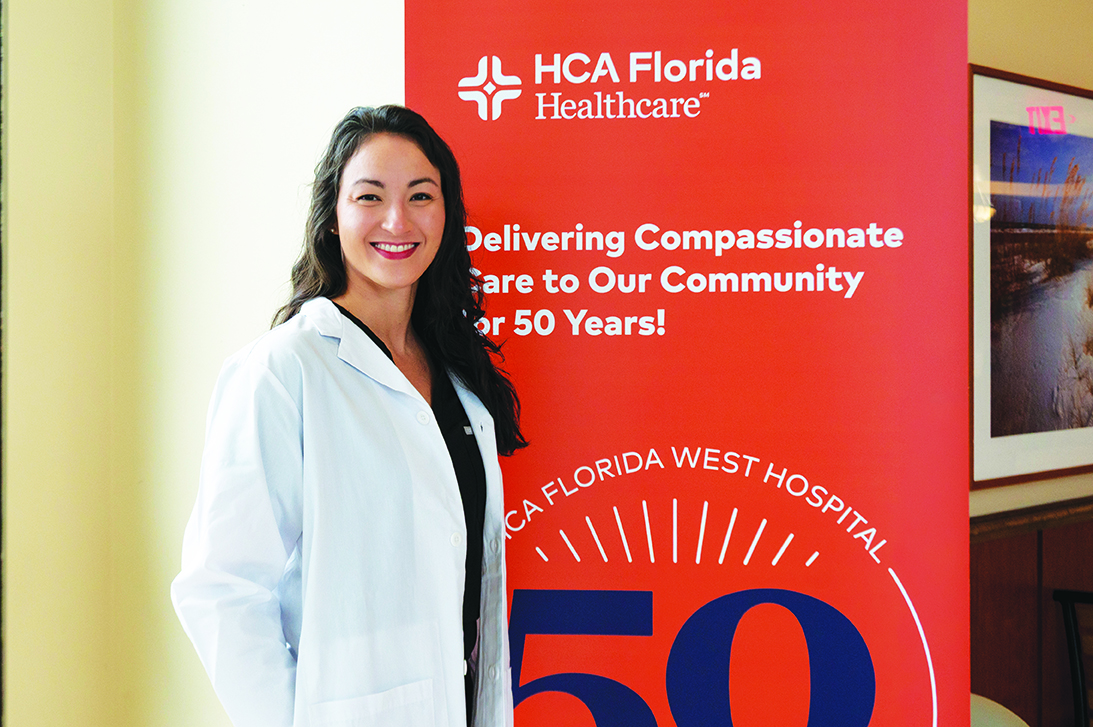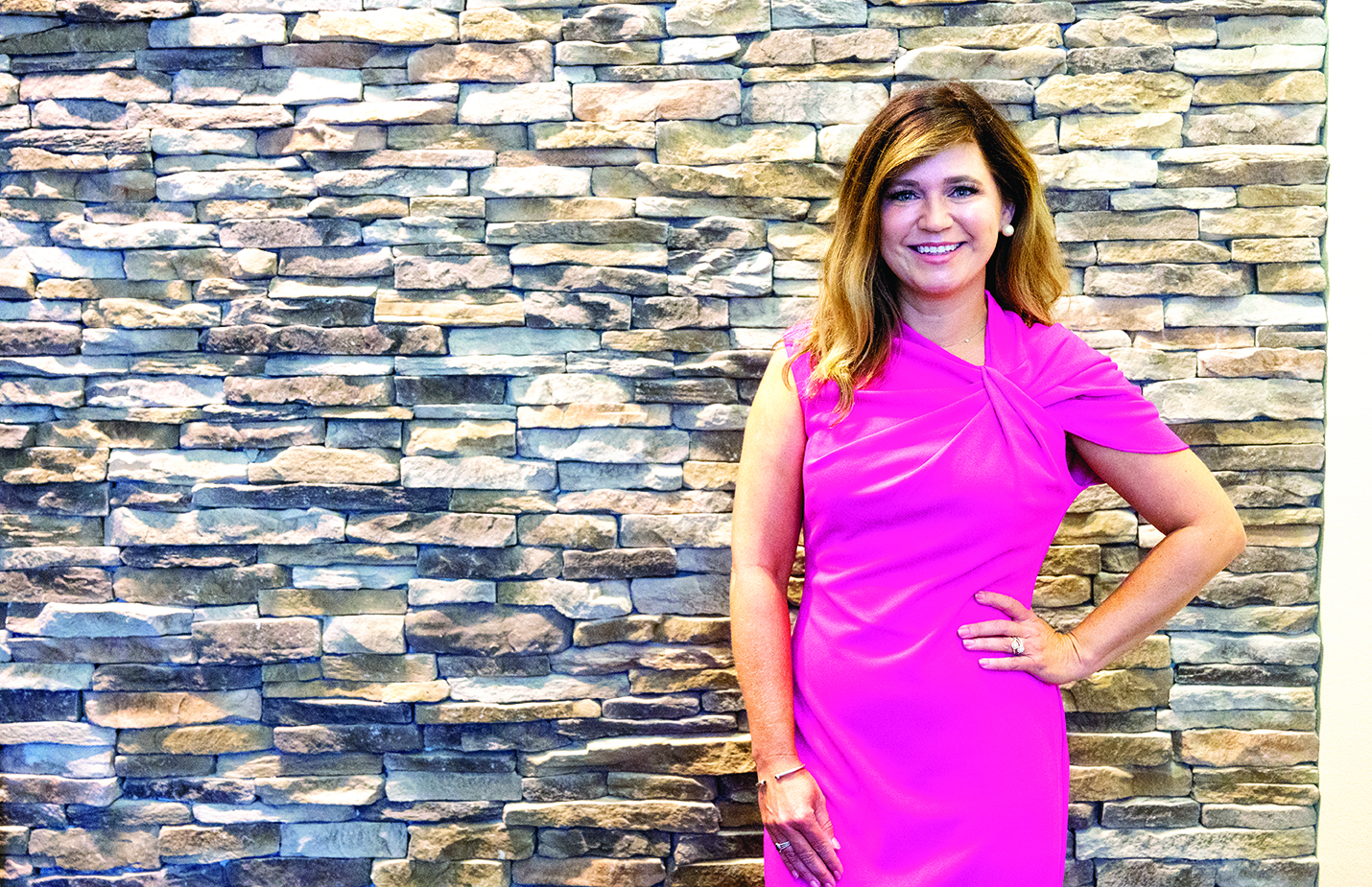A new era of breast cancer treatment.
Discover how shared decision-making and innovative surgical techniques are transforming the breast cancer journey for women everywhere.
By Kelly MacLeod / Photos by Kate Treick Photography

October marks Breast Cancer Awareness Month, a time to highlight advances in breast cancer diagnosis, treatment and survivorship. While curing the disease remains the foremost goal, increasing attention is now focused on improving aesthetic outcomes and preserving patients’ confidence and quality of life after surgery. Leading breast surgeons emphasize that treatment today integrates both effective cancer care and personalized reconstructive options to support a woman’s journey to recovery.
Dr. Rachel Astles, a board-certified OB-GYN at HCA Florida West Hospital, utilizes what is called “shared decision making” with patients.
“Shared decision making is where the doctor brings to the table the clinical knowledge that we have and then, with that information, try to figure out from the patient what he or she wants, and what their goals are.”
Dr. Jada Leahy, a breast-focused general surgeon in private practice here in Pensacola, reflects on the transformation breast cancer care has undergone in recent decades.

“The movement in the last 10 to 20 years has been really focused on multiple factors,” Leahy said. “Obviously, we’re there to cure cancer, but things like the aesthetic outcome, how a woman feels and her confidence after a devastating diagnosis — these things are now more in the forefront than they were even in my training 15 to 20 years ago.”
Echoing this holistic view, Astles highlights the crucial role of early detection and ongoing patient education.
“Women should know what’s normal and abnormal in their breasts, because about half of all breast cancers actually get detected by the women themselves feeling a lump or change,” Astles said. “Awareness is key to catching cancer early when options and outcomes are better.”
THE RISE OF ONCOPLASTICS
One of the most significant developments has been the adoption of oncoplastic surgery, which blends cancer removal with reconstructive techniques designed to optimize the breast’s appearance. Leahy said she openly discusses aesthetic concerns with patients early in the process.
“I ask my patients at their preoperative meeting, ‘How do you feel about your breast?’ A lot of times, that gets a little chuckle,” she said. “But there’s a candidness that women can have with other women. We can say that as part of appropriately treating your cancer, we can incorporate a procedure or some type of restructuring to give a better aesthetic outcome than they may even have had before surgery and before cancer.”
Professional organizations like the American Society of Breast Surgeons and the American College of Surgeons endorse these approaches. Leahy highlighted the vital psychological impact: “When women look in the mirror and they feel confident on the other side of their breast cancer journey, they don’t feel maimed or disfigured. They do better. There’s a good component of mental wellness and physical health that are intertwined.”
SURGICAL OPTIONS AND PATIENT CHOICES
Breast cancer surgery spans from breast-conserving surgery (lumpectomy) to total mastectomy. Lumpectomy is usually followed by radiation to reduce recurrence risk. Radiation oncologists, specialists who deliver therapeutic radiation, engage typically after surgery or chemotherapy completion, underscoring the multidisciplinary nature of treatment teams, alongside medical and surgical oncologists.
Leahy often serves as one of the first oncologic clinicians a patient meets.
“There are typically three physicians in a cancer treatment team: the surgeon, the medical oncologist and the radiation oncologist,” she explained.
The importance of understanding risk factors to tailor screening was underscored by Astles.
“If there’s a personal history of breast and ovarian cancers or even pancreatic or prostate cancers within the family, genetic counseling can identify hereditary risks and guide earlier or more frequent screening,” she said.
When a mastectomy is necessary, reconstruction becomes a key consideration. Leahy described three main reconstructive options widely used in the U.S.:
• Implant-Based Reconstruction: The most common method involves placing a temporary tissue expander at the time of mastectomy, which is gradually filled over months to stretch the skin, followed by surgery to replace it with a permanent implant. This careful approach respects the delicate blood supply of the skin flap and reduces complications. Leahy also notes that when women go home the same day as surgery, there is often less risk of infection, fewer blood clots and fewer operative risks. After the area has healed somewhat from the initial surgery, permanent implants can then be placed.
• Autologous Reconstruction: Also called flap reconstruction, this technique uses muscle, skin, and fat from another body area (commonly the lower abdomen, similar to a tummy tuck) to recreate a natural breast mound. While offering a very natural look and feel, it is more invasive and time-consuming and may not be available locally in all communities.
“It used to be reserved for folks that couldn’t tolerate prosthetic implant or had failed implant reconstruction. The restrictions are a little more liberal now,” Leahy noted.
• Prosthetic Breast Forms: For women who opt not to have surgery for reconstruction, external forms placed in bras or swimsuits offer a non-surgical alternative. “We have a beautiful prosthetic lab in town that helps us make those inserts,” Leahy said.
Astles added that patient values play a key role in choices.
“Some women may choose close monitoring or risk-reducing surgery if they are high risk, while others prefer regular breast screenings,” she said. “Ultimately, treatment must be personalized, respecting each woman’s priorities.”
Many patients are curious about nipple preservation. Leahy said it depends largely on breast size, shape and cancer involvement.
“Nipple preservation depends on the breast’s shape and risk of cancer involving the nipple,” she explained. “If the nipple is too far from the main blood supply or cancer involves the nipple-areola complex, it can be compromised. But, when possible, it offers a very natural appearance.”
Another option gaining attention is esthetic flat closure, where the breast and nipple are removed but the chest wall is closed to create a smooth, flat contour. This is embraced by women who may find large breasts uncomfortable and prioritize a flat, natural chest over reconstruction.
“A lot of women say, ‘I’ve had neck and back pain, I can’t buy shirts that fit, I don’t mind if my breasts are gone, because that’s not what defines me as a woman,’” said Leahy. “I think that is a beautiful movement.”
RISKS AND EDUCATING PATIENTS
Implant reconstruction carries risks, including infection, capsular contracture (painful scar tissue around implants) and rupture. Some patients report symptoms consistent with “implant illness,” though scientific literature does not confirm direct causation.
“There is no direct causality shown in the literature, but anecdotally, some patients feel better after implant removal,” Leahy shared. “Physicians have a duty to stay up to date and meet patients where they are. We educate together to make decisions.”
The importance of comprehensive education was echoed by Astles, who stressed, “Patients should understand their risk factors, the benefits and limits of screening and available preventive options.”
SCREENING AND RISK FACTORS
Emphasizing prevention and early detection, the American Cancer Society recommends women at average risk begin annual mammograms by age 40. Women with higher risk — for example, those with family histories of breast or ovarian cancer or genetic mutations such as BRCA — may need earlier or additional screening.
Lifestyle factors that increase breast cancer risk include heavy alcohol use, smoking and obesity. Genetic counseling and testing are available for some families, as certain inherited cancer syndromes cluster breast cancer with ovarian, pancreatic or prostate cancers.
THE PATIENT’S ROLE IN EARLY DETECTION
Education about breast awareness remains vital.
“About 50 to 60% of breast cancers are first detected by women themselves — they feel a lump or change,” an OB-GYN practicing in the region explained.
Women are encouraged to know their normal breast texture and appearance and promptly report changes such as new lumps or skin puckering to their healthcare provider.
“Knowing what your breasts look like in the mirror and what they feel like — is there a new lump? Is there new redness or skin puckering on one of them, armpits as well, the axilla, the armpit, is there a new lump there that wasn’t there a month ago?” Astles said.
Both doctors encourage you to speak with your doctor immediately if you do notice something different. If they determine testing is needed, a mammogram is typically the next step.
“The wonderful thing about screening tests is that we get to catch stuff really early,” explained Astles. “And if it looks even remotely suspicious, a lot of times, the radiologist will recommend additional images that might be more zoomed in different angles, and that’s why they call you back. And it could be to do a biopsy as well, which is they insert a needle into the mass and remove some of the cells to look at them under the microscope and determine what the mass actually is. That callback can definitely be very anxiety-inducing. But, oftentimes, it’s nothing. But it’s important to do, because sometimes there is something, and if it can be caught early enough, we treat it.”
Breast cancer surgery and reconstruction have evolved significantly, intertwining medical advances with holistic patient care. Surgical techniques now strive not only to eradicate cancer but also to restore esthetic form, dignity and confidence. Options from oncoplastic surgery to esthetic flat closures acknowledge diverse patient goals and bodies.
Leahy exemplifies this new paradigm: “If we can give women a semblance of normalcy when everything feels uncontrolled, that is just huge.”







